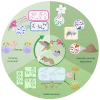Potential effects of nectar microbes on pollinator health
- PMID: 35491594
- PMCID: PMC9058548
- DOI: 10.1098/rstb.2021.0155
Potential effects of nectar microbes on pollinator health
Abstract
Floral nectar is prone to colonization by nectar-adapted yeasts and bacteria via air-, rain-, and animal-mediated dispersal. Upon colonization, microbes can modify nectar chemical constituents that are plant-provisioned or impart their own through secretion of metabolic by-products or antibiotics into the nectar environment. Such modifications can have consequences for pollinator perception of nectar quality, as microbial metabolism can leave a distinct imprint on olfactory and gustatory cues that inform foraging decisions. Furthermore, direct interactions between pollinators and nectar microbes, as well as consumption of modified nectar, have the potential to affect pollinator health both positively and negatively. Here, we discuss and integrate recent findings from research on plant-microbe-pollinator interactions and their consequences for pollinator health. We then explore future avenues of research that could shed light on the myriad ways in which nectar microbes can affect pollinator health, including the taxonomic diversity of vertebrate and invertebrate pollinators that rely on this reward. This article is part of the theme issue 'Natural processes influencing pollinator health: from chemistry to landscapes'.
Keywords: nectar chemistry; nectar microbe; plant-pollinator; pollinator health.
Conflict of interest statement
We declare we have no competing interests.
Figures


References
-
- Ananthakrishnan TN. 1982. Thrips and pollination biology. Curr. Sci. 51, 168-172.
-
- Kress WJ, Schatz GE, Andrianifahanana M, Morland HS. 1994. Pollination of Ravenala madagascariensis (Strelitziaceae) by lemurs in Madagascar: evidence for an archaic coevolutionary system? Am. J. Bot. 81, 542-551. (10.1002/j.1537-2197.1994.tb15483.x) - DOI
-
- Simpson BB, Neff JL. 1983. Floral biology and floral rewards of Lysimachia (Primulaceae). Am. Midl. Nat. 110, 249-256. (10.2307/2425266) - DOI
-
- Percival MS. 1961. Types of nectar in angiosperms. New Phytol. 60, 235-281. (10.1111/j.1469-8137.1961.tb06255.x) - DOI
-
- Baker HG, Baker I. 1983. Floral nectar constituents in relation to pollinator type. In Handbook of Experimental Pollination Biology (eds Jones CE, Little RJ), pp. 117-141. New York, USA: Van Nostrand Reinhold.
Publication types
MeSH terms
Substances
LinkOut - more resources
Full Text Sources

